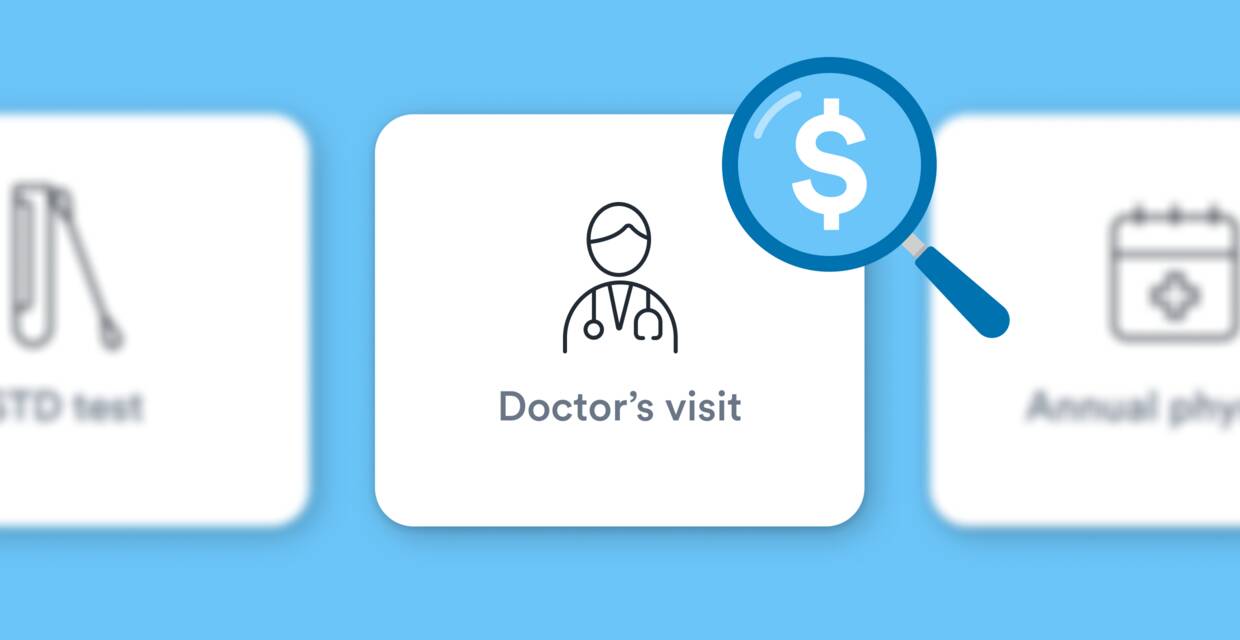Home>Finance>How Much Does A Telehealth Visit Cost Without Insurance


Finance
How Much Does A Telehealth Visit Cost Without Insurance
Modified: December 30, 2023
Find out the cost of telehealth visits without insurance and explore financing options. Ensure affordable healthcare with our comprehensive finance guide.
(Many of the links in this article redirect to a specific reviewed product. Your purchase of these products through affiliate links helps to generate commission for LiveWell, at no extra cost. Learn more)
Table of Contents
Introduction
Telehealth, also known as telemedicine, has emerged as a convenient and efficient way for people to receive medical consultations and treatment remotely. With advancements in technology, telehealth has become increasingly popular, especially in situations where in-person visits may be challenging or inconvenient. This has become particularly relevant in recent times, with the COVID-19 pandemic prompting the need for social distancing and limiting non-essential medical visits.
Telehealth allows patients to connect with healthcare professionals through video calls, phone calls, or secure messaging platforms. It offers a wide range of medical services, including primary care, mental health counseling, dermatology consultations, and follow-up care for chronic conditions.
One important consideration when exploring telehealth options is the cost. While telehealth can provide accessible and affordable healthcare, it’s essential to understand the potential expenses involved, particularly if you don’t have insurance coverage. In this article, we will delve into the various cost factors associated with telehealth visits, explore the average costs without insurance, discuss different pricing models, and highlight some affordable options.
Understanding Telehealth
Telehealth is a broad term that refers to the delivery of healthcare services remotely. It utilizes technology to connect patients with healthcare providers, enabling them to receive medical consultations, diagnoses, and treatment without physically visiting a healthcare facility. The goal of telehealth is to increase accessibility and convenience while maintaining the quality of care.
Telehealth encompasses various forms of communication, including video calls, phone calls, secure messaging, and online portals. It allows patients to interact with healthcare professionals in real-time or asynchronously, depending on the nature of the medical issue. This flexibility makes telehealth particularly useful for individuals in rural areas, those with limited mobility, or those who may have difficulty traveling to healthcare facilities.
Medical services provided through telehealth can vary widely and cover a range of specialties. Primary care consultations, mental health counseling, dermatology evaluations, and follow-up care for chronic conditions are just a few examples. Telehealth is also being increasingly utilized for prescription refills, monitoring of vital signs, and health education.
While telehealth cannot replace all in-person medical visits, it can effectively address many routine and non-emergency healthcare needs. It allows patients to receive prompt medical attention, get prescriptions, and access preventive care, thus reducing the burden on emergency rooms and healthcare systems.
Additionally, telehealth offers a level of convenience that traditional in-person visits cannot match. Patients can schedule appointments at a time that works best for them, eliminating the need to take time off work or rearrange their schedule. Telehealth also reduces travel time and expenses, making it a more cost-effective option for many individuals.
However, it’s important to note that not all medical conditions or situations can be effectively managed through telehealth. In cases where physical examination or diagnostic tests are necessary, healthcare professionals may recommend an in-person visit. Telehealth should be seen as a complement to traditional healthcare rather than a complete replacement.
Cost Factors in Telehealth Visits
When it comes to the cost of telehealth visits, several factors come into play. Understanding these factors can help you make informed decisions regarding your healthcare expenses. Here are some key elements that influence the cost of telehealth visits:
- Technology and Infrastructure: Telehealth visits require a reliable internet connection, a device (such as a computer or smartphone) with video conferencing capabilities, and appropriate software or telehealth platforms. The cost of these technological requirements may vary depending on your existing resources and the specific platform or service you use.
- Healthcare Provider’s Fees: The cost of telehealth visits can vary depending on the healthcare provider’s fees and the type of service provided. Just like traditional in-person visits, healthcare professionals determine their fees based on factors such as their expertise, location, and the complexity of the medical issue. It’s important to inquire about the fees associated with telehealth visits before scheduling an appointment.
- Insurance Coverage: Insurance coverage plays a significant role in determining the cost of telehealth visits. Some insurance plans cover telehealth services fully or partially, while others may require copayments or deductibles. It’s essential to check with your insurance provider to understand your coverage and any potential out-of-pocket costs. For those without insurance, the cost will be entirely self-pay.
- Medical Specialty and Complexity: The cost of telehealth visits may also depend on the medical specialty and the complexity of the medical issue being addressed. Specialists who provide more specialized care may have higher fees compared to primary care providers. Similarly, more complex medical issues may require longer consultation times, resulting in higher costs.
- Additional Services or Testing: In some cases, telehealth visits may lead to the need for additional services or testing. For instance, a dermatologist might recommend a biopsy that requires an in-person visit. These additional services or testing may incur additional costs beyond the telehealth consultation.
It’s important to discuss the cost factors with your healthcare provider and clarify any financial concerns before scheduling a telehealth visit. By doing so, you can ensure transparency and make informed decisions about your healthcare expenses.
Average Cost of Telehealth Visits Without Insurance
For individuals without insurance coverage, the cost of telehealth visits can vary depending on several factors, including the healthcare provider, the type of service required, and the geographical location. While specific costs may differ, understanding the average cost range can provide a general idea of what to expect.
On average, a telehealth visit without insurance can range from $40 to $200 per consultation. However, it’s important to note that these costs are approximate and can vary significantly. Factors such as the complexity of the medical issue, the duration of the visit, and the healthcare provider’s fees can influence the final cost.
Some healthcare providers offer flat-rate fees for telehealth consultations, while others charge per minute or per session. The duration of the visit may depend on the nature of the medical issue and can range from 15 minutes for a routine primary care consultation to 60 minutes or more for a specialty consultation or mental health counseling session.
It’s worth mentioning that certain telehealth platforms or services may offer subscription-based plans or discounted rates for individuals without insurance. These plans often include access to a network of healthcare professionals and can provide cost savings for frequent or ongoing telehealth needs.
It’s important to inquire about the specific costs associated with telehealth visits and any potential hidden fees when scheduling an appointment. Transparency in pricing and financial discussions with healthcare providers can help patients make informed decisions about their healthcare expenses.
It’s also worth exploring alternative options if the cost of a telehealth visit without insurance seems prohibitive. Some healthcare providers offer sliding scale fees or discounts based on income, and there may be local community health clinics or non-profit organizations that provide low-cost or free telehealth services for eligible individuals.
Ultimately, the average cost of telehealth visits without insurance may vary, and it’s important to evaluate individual circumstances and explore different options to find the most affordable and suitable solution.
Pricing Models in Telehealth
Telehealth follows various pricing models, with healthcare providers and telehealth platforms implementing different approaches to determine the cost of services. Understanding these pricing models can help you navigate the telehealth landscape and choose the option that best fits your needs and budget.
Here are some common pricing models in telehealth:
- Fee-for-Service: This is the most common pricing model in telehealth. Providers charge a specific fee for each telehealth visit, similar to traditional in-person consultations. The fee can be based on the duration of the visit, the type of service, or a flat rate. Fee-for-service models are often transparent, allowing patients to know the cost upfront.
- Subscription-Based: Some telehealth platforms offer subscription-based pricing models. Patients pay a monthly or annual fee to access a network of healthcare professionals for unlimited telehealth visits. These subscription plans are especially beneficial for individuals requiring frequent telehealth consultations or for those who prefer knowing the total cost in advance.
- Per-Minute Billing: In certain cases, healthcare providers may charge on a per-minute basis. This pricing model is particularly common for mental health counseling or therapy sessions conducted through telehealth. Instead of a fixed fee, patients are charged based on the actual time spent in the session.
- Bundled Packages: Some telehealth providers offer bundled packages that include multiple telehealth visits or a combination of services at a discounted price. These packages are often designed for specific healthcare needs, such as prenatal care, chronic disease management, or dermatology consultations.
- Membership-Based: Another approach to telehealth pricing is a membership-based model. Patients pay a monthly or annual fee to become a member of a telehealth service, which grants them access to discounted rates or free telehealth visits. These membership models are commonly offered by direct-to-consumer telehealth companies.
It’s important to carefully review the pricing models and compare them to your healthcare needs and budget. Consider factors such as the frequency of telehealth visits, the type of services required, and any potential additional costs that may arise.
When researching telehealth platforms or providers, be sure to inquire about their pricing structure and any potential hidden fees. Transparency in pricing will help you make an informed decision and avoid any unexpected financial surprises.
Keep in mind that some telehealth services may accept health insurance, while others exclusively cater to self-pay patients. If you have insurance coverage, check with your provider to understand if telehealth visits are covered and the associated out-of-pocket costs.
By understanding the various pricing models in telehealth, you can select a cost-effective option that delivers the care you need while aligning with your financial circumstances.
Affordable Options for Telehealth Without Insurance
For individuals without insurance coverage, the cost of telehealth visits can be a concern. However, there are several affordable options available to access telehealth services without insurance. Exploring these options can help you receive the medical care you need while minimizing your out-of-pocket expenses.
Here are some affordable options for telehealth without insurance:
- Community Health Clinics: Local community health clinics often provide low-cost or free telehealth services to individuals who cannot afford traditional healthcare. These clinics are typically funded by federal grants or state programs and are dedicated to serving underserved populations. They offer a range of services, including primary care consultations, mental health counseling, and preventive care.
- Non-Profit Organizations: Some non-profit organizations have telehealth programs in place to deliver affordable healthcare to specific communities or demographic groups. These organizations may provide telehealth services at reduced rates or on a sliding scale, based on the individual’s income level.
- Direct-to-Consumer Telehealth Companies: Several direct-to-consumer telehealth companies have emerged, offering affordable and accessible healthcare services for individuals without insurance. These companies often have transparent pricing structures and may offer discounted rates for self-pay patients. Some of them also provide subscription plans for unlimited telehealth visits within a specified time frame.
- Medical Discount Plans: Medical discount plans are membership-based programs that offer discounted rates on a wide range of healthcare services, including telehealth. These plans, which typically involve a monthly or annual fee, can provide substantial savings on telehealth consultations and other medical expenses.
- Telehealth Apps: There are various telehealth apps available that connect patients with healthcare providers directly. These apps often offer competitive pricing and affordable options for telehealth visits. Research and compare different apps to find a suitable one that matches your needs and budget.
When exploring these affordable options, it’s crucial to ensure that the telehealth services provided meet your specific healthcare needs. Consider factors such as the availability of healthcare professionals, the types of services offered, and the reputation of the provider or organization.
It’s also important to keep in mind that while these options may offer cost savings, they may not cover all healthcare needs or conditions. In some situations, an in-person visit with a healthcare provider may still be necessary. Discuss any concerns or questions with the telehealth provider to determine the most appropriate course of action for your specific medical situation.
By taking advantage of these affordable options for telehealth without insurance, you can access the medical care you need while managing your healthcare expenses effectively.
Conclusion
Telehealth has revolutionized the way healthcare is delivered, providing a convenient and accessible solution for individuals to receive medical consultations and treatment remotely. While the cost of telehealth visits can vary depending on various factors, understanding the cost factors, average costs without insurance, pricing models, and affordable options can help you make informed decisions about your healthcare expenses.
It’s essential to consider factors such as technology requirements, healthcare provider’s fees, insurance coverage, medical specialty, and the possibility of additional services or testing when determining the cost of telehealth visits. Understanding these factors and discussing them with your healthcare provider can provide transparency and prevent any unexpected financial surprises.
For individuals without insurance coverage, the average cost of telehealth visits without insurance can range from $40 to $200 per consultation. However, it’s advisable to inquire about specific costs and explore alternative options if the cost seems prohibitive. Community health clinics, non-profit organizations, direct-to-consumer telehealth companies, medical discount plans, and telehealth apps are affordable alternatives to consider.
It’s important to note that while telehealth offers convenience and cost savings, it cannot replace all in-person medical visits. Some medical conditions or situations may still require physical examination or diagnostic tests. Telehealth should be seen as a complementary option for routine and non-emergency healthcare needs.
In conclusion, telehealth provides individuals with the opportunity to access quality healthcare remotely. By understanding the cost factors and exploring affordable options, you can receive necessary medical care while managing your healthcare expenses effectively. With continued advancements in technology and increased acceptance of telehealth services, the landscape of remote healthcare is set to expand, offering more accessible and affordable options in the future.














